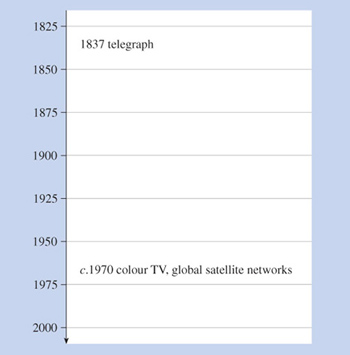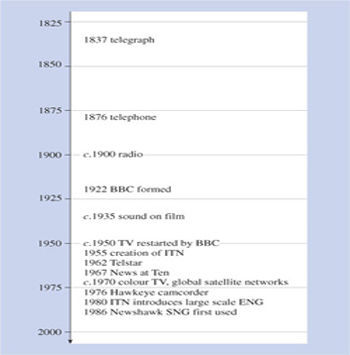2.7 Digitisation of the news
Into the digital era
Remember that this paper was written in 1995, at which time digital techniques were just beginning to take over in electronic newsgathering. Taylor therefore concludes his paper with comments on the nature and impact of changing to digital techniques.
By the mid-1990s therefore one could be forgiven for thinking that news providers had all the technology they needed to deliver real news from more or less anywhere in the world.
And indeed we have.
So what is it that now attracts news companies to an all digital solution for newsgathering, post production and transmission?
Well, the traditional broadcast industry view is of course well known: digital brings consistent high quality pictures and sound from reliable, stable equipment which requires minimal or in some cases zero routine alignment.
Digital techniques together with advances in VLSI and [other developments in electronics], have opened the way for video signal processing to be carried out on economically priced standard computer platforms, with appropriate software, to give broadcasters much greater choice and ever more function per pound spent – great news when wrestling with hard-pressed capital budgets.
These benefits are attractive to news companies too, but the real bonus which drives our interest is the potential for digital computer based solutions to deliver high quality news programmes free from the multigeneration limitations of analogue VTRs and the editorial inflexibility of tape based production where stories cannot easily be altered or updated and at the same time achieve substantial operational cost savings.
[…]
[L]et me conclude by highlighting what I believe to be the digital newsgathering promise:
-
More efficient newsgathering.
-
More options for getting the story back.
-
Faster post production.
-
Greater editorial freedom.
-
Broad multiskilling opportunities.
-
Easier automation.
-
Improved technical quality.
-
Lower operating costs.
I make no excuse for emphasising the cost saving elements that digital news operations should achieve.
News companies are having to compete in an ever more cost conscious broadcasting industry. Our greatest asset is our staff but regrettably it is also our most expensive cost.
Yes, all the quality and other operational benefits of this technology are highly desirable and contribute toward a news provider's competitive edge, but at the end of the day it is the potential cost savings primarily achieved through multiskilling and job elimination which are the main attraction to news providers.
It is for this reason that I stated at the start of my presentation that the impact of this particular technology revolution is going to be bigger than anything we have experienced in the past.
[…]
Alignment. Analogue electronic equipment often requires adjustments in order for it to perform at its best. On magnetic tapes, for example, it might be necessary to adjust the position of the record and playback heads on the tape, and the record and playback levels might have to be adjusted up or down. Generally speaking, it is much easier to make digital systems independent of alignments. This is because the exact details of the symbol do not matter, provided you can tell whether a symbol is representing a 1 or a 0.
VLSI is very-large-scale integration. Originally, electronic circuits were built from 'discrete components' (such as resistors, capacitors, inductors and transistors – but you do not need to know what these all are). A single component would do one job, and a complicated electronic circuit would be built up from many components. Later, integrated circuits (ICs) came along, which combined many components on a single 'silicon chip'. As the technology advanced, more and more components could be fitted onto a single integrated circuit so that the single device (single chip) could do more and more advanced functions. Integrating large numbers of components onto a single chip was called 'large-scale integration', then getting even more onto a chip was 'very-large-scale integration'. I am not sure if anyone has precisely defined 'large' and 'very large' in this context.
Video signal processing. When you have an image encoded electronically (the video signal), you can manipulate it to do things like change colours or remove unnecessary detail. Manipulating a signal in this way, for whatever purpose, is known as signal processing.
Multigenerational limitations. Each time a copy is made from an analogue signal – video or audio – there is inevitably a degradation in quality, because copying can never be perfect. Thus, there is a limit to the number of 'generations' of copies that can be made. The maximum number of generations before the quality becomes unacceptable depends upon the copying process and the application, but typically we are talking in terms of three or four. With digital signals this effect can be virtually eliminated, because digital signals can be regenerated and then they are 'as good as new'.
VTR stands for video tape recorder.
Stories cannot easily be altered. As I shall be discussing later, the fact that stories can be easily altered with digital systems is not always beneficial!
The term post production refers to the collection of processes that are done to a sequence of video or audio after the filming or recording. The processes include editing and signal processing.
Activity 5
Taylor's paper highlights a number of important dates in the development of newsgathering and news broadcasts. A good way of getting a picture of historical developments is to plot events on a time line. Figure 2a begins this for some of the events mentioned by Taylor. Go back over Taylor's paper and extract more dates to add to a copy of the time line. (I found another eleven events to add.) Note that the use of 'c', an abbreviation for 'circa' meaning 'about', indicates an approximate date, as in c.1970 for 'about 1970'.
Activity 6
When considering the relationship between technology and society it is often helpful to consider influences in two directions:
-
Technology push. Newly developed technology creates a need that wasn't there before.
-
Demand (or market) pull. Users have a need, and technology is deliberately developed to satisfy that need.
Thinking in terms of the user as the news industry (journalists, and newspaper, radio or TV businesses in general), there is evidence of both technology push and demand pull in Taylor's description.
Identify one example of each, and support your answer with quotes from Taylor's paper.
Discussion
The example which I thought indicated technology push was the use of cinema for newsreels:
The visual power of cinema as a news medium was quickly recognised and organisations such as British Movietone News and Pathe News soon established themselves with 'newsreels' which were a compilation of the week's best visual stories shot and made on high-quality 35 mm film.
Taylor (1995)
I thought that the clearest example of demand pull was the development of the Newshawk for satellite newsgathering:
Well, there were still large areas of the world which did not have wideband cable infrastructure or possess large expensive satellite ground stations and these became the next technological battleground.
These communication dead spots provided the challenge to fire the development of transportable ground stations.
In 1985 ITN formed an alliance with the IBA and McMichael Electronics to develop the world's first SNG uplinks – the Newshawk – which we first used in 1986.
Taylor (1995)


